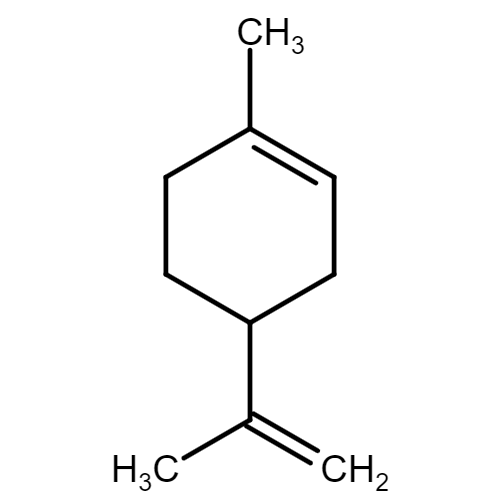limonene
| Compound Structure: |

|
||||||||||||||||||||||||||||||||||||||||||||||||||
|---|---|---|---|---|---|---|---|---|---|---|---|---|---|---|---|---|---|---|---|---|---|---|---|---|---|---|---|---|---|---|---|---|---|---|---|---|---|---|---|---|---|---|---|---|---|---|---|---|---|---|---|
| Synonyms: | 1,8(9)-p-Menthadiene; 1-Methyl-4-(1-methylethenyl)cyclohexene; 1-Methyl-4-isopropenyl-1-cyclohexene; 4 Mentha 1,8 diene; 4-Isopropenyl-1-methyl-cyclohexene; Achillies dipentene; Acintene DP; Cyclohexene, 1-methyl-4-(1-methylethenyl)-; Cyclohexene, 1-methy | ||||||||||||||||||||||||||||||||||||||||||||||||||
| Compound ID: | NMPC-005 | ||||||||||||||||||||||||||||||||||||||||||||||||||
| PubChem ID: | |||||||||||||||||||||||||||||||||||||||||||||||||||
| Molecular Formula: | C10H16 | ||||||||||||||||||||||||||||||||||||||||||||||||||
| Canonical SMILES: | CC1=CCC(CC1)C(=C)C | ||||||||||||||||||||||||||||||||||||||||||||||||||
| InChIKey: | XMGQYMWWDOXHJM-UHFFFAOYSA-N | ||||||||||||||||||||||||||||||||||||||||||||||||||
| About the compound: | Limonene is a cyclic monoterpene and is one of the major constituents in citrus essential oils. Chemically, limonene can exist in two enantiomeric forms: D-limonene and L-limonene. D-limonene is the more commonly encountered form and has a pleasant orange scent. L-limonene has a turpentine-like odor. Limonene is predominantly found in the oils of citrus fruits like oranges, lemons, limes, and grapefruits. It contributes significantly to the characteristic smell of these fruits. However, it's not limited to citrus; limonene can also be found in small amounts in various other plants and trees. Limonene, especially D-limonene, is commonly used in food, beverages, and candies for its pleasant citrus flavor. It's also used in cosmetics, cleaning products, and perfumes for its fresh, citrusy scent. Due to its good solvency properties, D-limonene is often used as an ingredient in eco-friendly cleaning products. It's particularly effective at dissolving oils and greases. Limonene can be used as a natural solvent in some industrial applications, replacing more toxic or environmentally harmful solvents. Preliminary studies have suggested that limonene may have various health benefits, including anti-inflammatory, antioxidant, and even anticancer properties. Some research has explored its potential use in skin care and therapeutic treatments.D-limonene's pleasant smell makes it a favorite in aromatherapy, where it's believed to have uplifting and stress-reducing effects. Safety
and Hazard GHS Hazard Statements H226:
Flammable liquid and vapor [Warning Flammable liquids] H315:
Causes skin irritation [Warning Skin corrosion/irritation] H317:
May cause an allergic skin reaction [Warning Sensitization, Skin] H400:
Very toxic to aquatic life [Warning Hazardous to the aquatic environment, acute
hazard]
H410: Very toxic to
aquatic life with long lasting effects [Warning Hazardous to the aquatic
environment, long-term hazard] |
||||||||||||||||||||||||||||||||||||||||||||||||||
| Properties: |
Chemical
and Physical Properties
Source: PubChem |
||||||||||||||||||||||||||||||||||||||||||||||||||
| Source Species: |
Ficus asperifolia Heeria insignis Monodora myristica Monodora tenuifolia Pachira glabra Phyllanthus muellerianus Solanum nigrum Tithonia diversifolia Araucaria cunninghamii Brachystegia nigerica Brachystegia eurycoma Eucalyptus tereticornis Hyparrhenia rufa Tagetes erecta Taxodium distichum Eugenia uniflora Eucalyptus torelliana Callitris columellaris Morinda lucida Murraya Koenigii Polyalthia suaveolens Vitex simplicifolia Olax mannii |